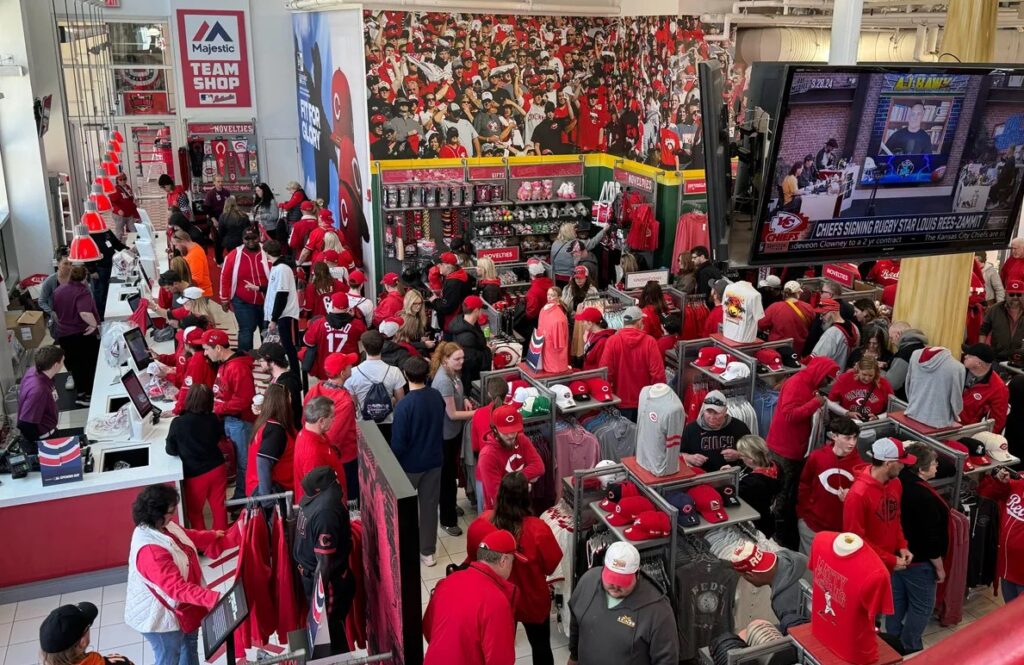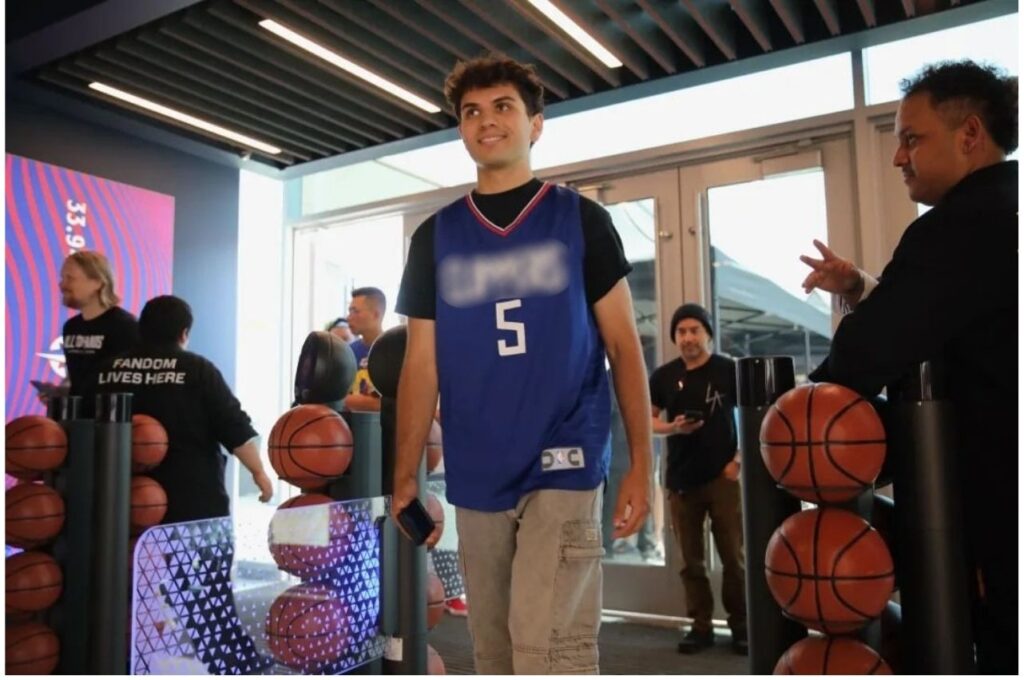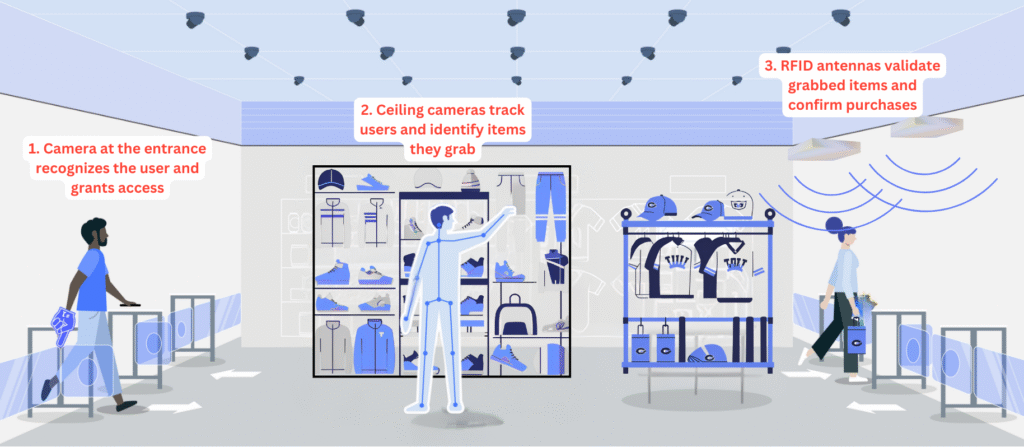
Introduction
Sports merchandise retail is a fast-paced game of its own. Whether it’s a team store in a stadium packed with fans or an online shop bracing for a championship merchandise rush, retailers face unique challenges. Inventory can swing wildly – one day you’re stuck with unsold jerseys of a traded player, the next day you’re sold out of championship t-shirts. In brick-and-mortar venues, intense crowd surges before the game or during halftime lead to long checkout lines and missed sales. In e-commerce, inaccurate stock counts can result in customers ordering items that aren’t actually available, causing canceled orders and lost trust. All these issues translate to real costs: typical stadium retailers operate with only ~63% inventory accuracy, leading to oversupply of low-demand items and shortages of hot sellers. Long lines mean lost revenue – an estimated 4% annual revenue is lost because 30% of fans abandon checkout if they wait over 15 minutes. And when popular items are out of stock, 85% of shoppers won’t buy a substitute, causing revenue to evaporate (one arena store lost an estimated $1.8 million yearly this way) Canva. These pain points are felt across all sports retail operations, from football to baseball to soccer merch. The good news? Radio Frequency Identification (RFID) technology is helping sports merchandise retailers overcome these challenges in both physical stores and online channels.
Inventory Accuracy: The Foundation of Winning Sales
For sports retailers, knowing exactly what’s in stock – in real time – is like knowing the score at all times. RFID gives each item a “voice” through a tiny radio tag, allowing retailers to automatically track products throughout the supply chain and in stores without manual counting. The result is transformational accuracy. Retailers that historically only had around 60% inventory accuracy can reach 98–99% accuracy with RFID, virtually eliminating blind spots. This drastic improvement means far fewer out-of-stock surprises (reducing out-of-stock rates by about 50%) and a 2–10% boost in sales thanks to better product availability. In practice, this has been proven by real-world deployments – for example, the Nordic sporting goods chain Stadium rolled out item-level RFID across 180 stores and shot its inventory accuracy from roughly 70% up to 99%, with significant sales increases across all product lines as a result.
Crucially, RFID-driven accuracy benefits both brick-and-mortar and e-commerce operations. With a live view of inventory, stock counts in physical team stores sync with the online store, enabling true omnichannel sales. In other words, RFID ensures your website only sells what you actually have. This prevents the frustrating scenario of a fan ordering a jersey online, only to be later told it’s out of stock. It also powers services like BOPIS (Buy Online, Pick Up In Store) or even buy online for pickup at the stadium – since inventory data is trustworthy, the right item will be waiting for the fan. Some retailers have even seen omnichannel and BOPIS sales rise 1–5% after RFID adoption, while slashing clearance markdowns by 30% due to better stock management. In short, RFID gives sports retailers championship-level inventory accuracy, forming the foundation for higher sales and seamless omnichannel experiences.
Faster Restocking and Operational Efficiency
RFID doesn’t just tell you what’s in stock – it also supercharges all the operational tasks around inventory. Consider the traditional way of doing inventory counts: store staff would manually scan barcodes or tally items, which in a large team store could take many hours (often an overnight effort) and still be error-prone. RFID transforms this process. Workers can walk the store with a handheld RFID reader or even set up fixed readers, and capture thousands of tags per second without line-of-sight. The numbers are staggering: using RFID, staff can scan 20,000+ items per hour (versus only ~300 per hour with barcodes). That’s roughly a 25× increase in stock-taking speed. In practical terms, what might have been a full-day inventory count can be done in minutes. For instance, Fanatics – a leading sports merchandise retailer – reported that with RFID they complete a full inventory count in under an hour, whereas it used to take 6–8 hours with manual methods rfidjournal.com. This dramatic efficiency gain means stores can perform cycle counts far more frequently (some do it daily now), keeping inventory records highly accurate and catching discrepancies early.
RFID technology streamlines store operations. Modern stadium merchandise shops, such as the Boston Bruins’ pro shop at TD Garden, use RFID self-checkout kiosks and automated inventory tracking to speed up transactions and keep shelves stocked.
The benefits extend to restocking and supply chain as well. With RFID, as soon as an item sells, the system knows – triggering replenishment from the stockroom or warehouse faster than before. Retailers have seen replenishment cycles speed up by 30–50% thanks to this real-time visibility and automated alerts Canva. Goods receiving and shipping are also expedited: an incoming box of new jerseys can be scanned all at once through an RFID portal, verifying the contents in seconds with no need to individually handle each item. This ensures that popular items get onto the sales floor (or updated as “in stock” online) without delay. The labor savings are considerable – one analysis found RFID can cut labor hours spent on inventory management by around 90%. Employees freed from tedious scanning tasks can instead focus on engaging with customers and merchandising. Overall, RFID brings a leaner, more efficient operation where shelves are restocked promptly and staff productivity soars.
Slashing Shrinkage and Preventing Theft
Shrinkage – which includes shoplifting, employee theft, and fraud – is a persistent issue in retail, and sports merchandise is no exception. Crowded stadium stores can be chaotic, and high-value logo apparel or memorabilia are attractive targets for thieves. RFID technology offers a strong defense against these losses, effectively acting as a smart security guard for each item. Every RFID tag carries a unique identifier, and RFID-based systems integrate with security gates or readers at exits to detect unpaid merchandise. Unlike traditional anti-theft tags (RF or AM hard tags), RFID tags not only trigger alarms but also identify exactly which item is being stolen (and even log the time and item details of the theft attempt). This information can be used to alert staff immediately and even integrate with video surveillance to catch thieves in the act and for police reports. Additionally, RFID allows for “invisible” loss prevention – tags can be embedded in labels or inside products, and stores can use discreet overhead or hidden floormat antennas instead of clunky gate antennas at the door and maintain an open, inviting entrance for fans while still protecting goods.
The impact on shrink can be dramatic. Industry data shows that comprehensive RFID item-level tagging and tracking can reduce shrinkage by 50–75% by deterring theft and flagging fraudulent returns. In fact, by linking each item sold to its RFID tag in the point-of-sale system, retailers can automatically detect if someone tries to return a counterfeit product or an item that was never purchased (or was already returned), shutting down fraudulent returns that plague sports apparel and merchandise stores. These reductions in theft and fraud not only preserve higher margins, but also lower the costs of insurance and security for the retailer. For sports merchandise retailers, fewer losses mean more genuine profits from each season. With RFID acting as a 24/7 sentry, loss prevention becomes significantly more effective, allowing retailers to confidently display high-value merchandise (like authentic jerseys, signed collectibles, and championship gear) without as much fear of it “walking out” unpaid.
Enhancing the Fan Experience (and Driving Sales)
At the end of the day, success in sports merchandise retail hinges on happy customers – the fans. RFID technology directly enables a smoother, faster, and more engaging shopping experience for fans both in stadiums and online. One of the biggest friction points in stadium stores has always been the checkout line. Fans are in a hurry to get back to the game, and long waits will turn them away (remember that almost one-third of fans abandon purchases if they have to wait 15+ minutes Canva). RFID tackles this problem head-on by enabling frictionless checkout. Instead of scanning each item’s barcode one by one (or removing tags), an RFID checkout station can instantly ring up all items in a pile. This technology is often deployed in self-checkout kiosks: the fan simply drops their selected items into an RFID reader bin or onto a counter, and within seconds the screen displays their total. Payment is tapped and they’re done – no unwieldy tag detachers or manual scans needed. The speed gain is remarkable: RFID self-checkout systems have cut transaction times by about 75% (for example, from ~45 seconds per customer to around 12 seconds). Fans certainly notice the difference. At Boston’s TD Garden, for instance, two team merchandise stores introduced an RFID-based self-checkout system and now let shoppers “grab and go” in a matter of seconds. The result? Merchandise sales doubled (a 100% increase) after deploying RFID checkout rfidjournal.com – largely because more fans are willing to buy when they don’t have to endure a long line. Faster checkout not only prevents lost sales, it actively boosts revenue as happy fans make impulse buys and spend more time enjoying the event.

It’s clear that fans appreciate these improvements. In a survey about the “stadium of the future,” 59% of fans said they would pay extra for shorter wait times, and 63% prefer self-service kiosks for the speed and convenience Canva. RFID enables both of these desires, making shopping at the arena almost as exciting as the on-field action. Beyond checkout speed, RFID contributes to a better shopping experience through reliable stock availability and personalization. When inventory is accurate and replenished efficiently, fans can find the exact jersey or cap they came for, in the right size, without disappointment. Some retailers have even used RFID data to guide fans to products – for example, handheld “Geiger counter” style RFID scanners let staff quickly locate that last medium home jersey hidden on a rack, reducing the time a fan spends searching by an estimated 18%. And if a product is out of stock in-store, RFID data from across the system can instantly tell the associate if it’s available at another location or warehouse, so the sale can still be captured via online order or delivery.
For e-commerce shoppers, the RFID advantage comes through faster fulfillment and accuracy. Orders are less likely to be canceled for stock errors, and items ship out faster when warehouse pickers can instantly verify picks with RFID scans. Some sports retailers even embed RFID in warehouse processes so that as soon as an online order is assembled, all items in the box can be verified in one go, virtually eliminating wrong-item shipments. The end result for the customer is that they get the right fan gear, delivered on time, with far fewer hiccups. In fact, retailers report higher customer satisfaction and loyalty after RFID implementation, as fans grow to trust that the item showing “in stock” online is truly available and that in-person shopping is quick and hassle-free rfidjournal.com. From the stadium to the smartphone, RFID is enhancing the fan’s shopping journey at every turn.
Real-World Success Stories and ROI
RFID may sound high-tech, but it’s far from experimental – it’s delivering real results for sports merchandise retailers today. We’ve already seen how Fanatics leveraged RFID to speed up inventory counts and streamline checkout in their stores, how Stadium boosted sales by perfecting inventory accuracy, and how TD Garden’s pro shop doubled sales with frictionless checkout. These are not isolated wins; they reflect broader trends across sports retail. Major athleisure brands and sporting goods chains around the world have adopted RFID and report significant gains. For example, global retailer Decathlon (though not focused on team merch) famously saw such efficiency improvements that it RFID-tagged 100% of its products and became a pioneer in retail RFID usage gs1us.org. And technology providers like Zebra and Impinj have partnered with leagues (the NFL uses Zebra’s RFID to track game-used jerseys for authentication and fans’ collection, in addition to on-field tracking) and venue operators to bring this tech to team shops everywhere rfidjournal.com.
The investment in RFID yields a strong payoff. According to an analysis by Invento RFID, a mid-sized sports arena that invested $200,000 in RFID saw a full return on investment in just 6 months and an 80–120% annual ROI thereafter. The combined effect of increased sales (fewer stockouts and faster checkouts), lower losses, and leaner inventory levels makes the business case clear. In concrete terms, retailers have observed around 2–4% sales uplift from having fewer out-of-stocks, an additional 5–10% sales conversion uptick by leveraging features like back-in-stock alerts (made possible by real-time inventory data), and fans spending 12–18% more per capita when wait times are slashed by RFID fast checkout. On the cost side, holding inventory has become ~10–30% cheaper in terms of cash tied up, because RFID lets stores optimize stock and avoid overstocking. And with labor efficiency and shrink improvements, the savings pile on. All these benefits directly contribute to a healthier bottom line for sports merchandise retailers.
One of the best real-world examples of these advantages in action is at the Intuit Dome, home of the Los Angeles Clippers – a standout case of RFID working in concert with spatial intelligence. The arena’s flagship and nine satellite team stores deployed Invento’s RFID platform with AiFi’s computer‑vision network of cameras. Fans check in with the Clippers + Intuit Dome app, grab gear, and simply walk out; cameras follow the shopper while RFID readers at the exit verify the exact SKU and size, ensuring 100 % accurate charges. The venue features multiple merchandise stores built on the same hybrid architecture, making Intuit Dome the first arena aiming for an all‑autonomous retail footprint. Early results have achieved sub‑10‑second transactions with virtually zero mis‑attributed items, setting a new benchmark for frictionless fan retail. (rfidjournal.com, stadiumtechreport.com)

Conclusion: Scoring Big with RFID
In an industry as dynamic and passion-driven as sports, merchandise retailers need every advantage to keep fans happy and business booming. RFID technology offers a compelling, field-tested solution to the most pressing challenges these retailers face. It eliminates inventory guesswork, ensuring the right jerseys and souvenirs are always available both in-store and online. It cuts down theft and errors, protecting slim margins from shrinkage. It streamlines operations, from back-room stock counts to front-end checkouts, freeing staff to focus on customers and game-day excitement. Most importantly, RFID elevates the fan experience – no more frustrating sold-outs or long waits, just quick and easy shopping so fans can get back to cheering on their team with new gear in hand.
For sports merchandise retailers across all leagues and sports, RFID is proving to be a true game changer. It marries the physical and digital sides of retail into one coherent system, perfectly suited for today’s omnichannel world where a fan might buy at the stadium one week and on the app the next. Early adopters have already scored impressive wins in sales growth, efficiency, and customer satisfaction. As the cost of RFID has come down and the technology has matured, it’s increasingly accessible even to mid-sized team shops and college athletics retailers, not just the pros. Implementing RFID is an investment in accuracy, agility, and fan engagement – one that pays off with championship-level results. In the competitive arena of retail, embracing RFID is how sports merchandise sellers can stay ahead of the game and turn every fan interaction into a winning play.